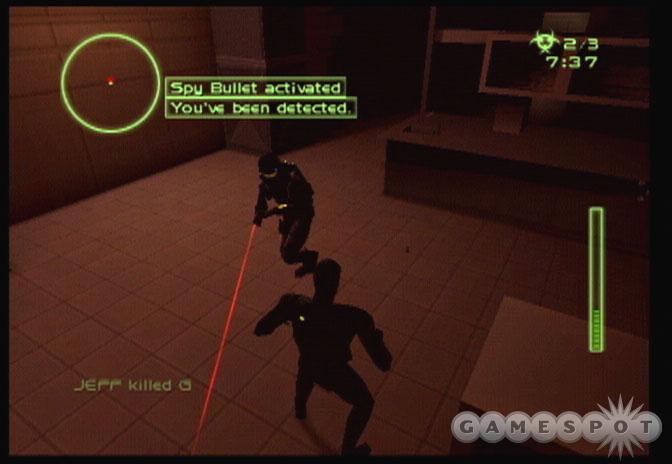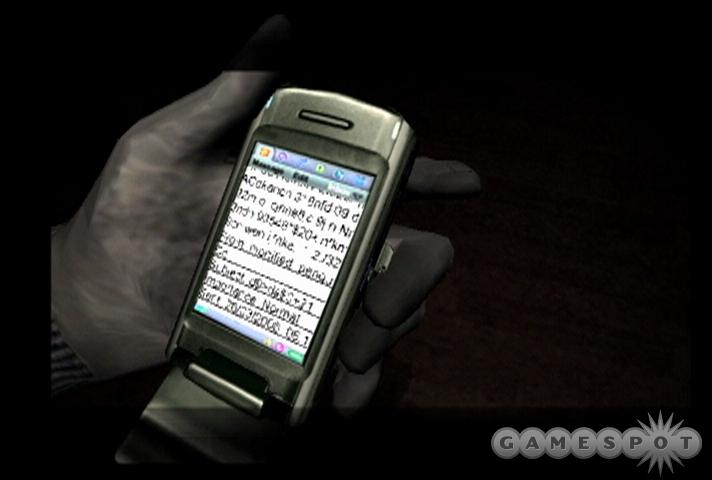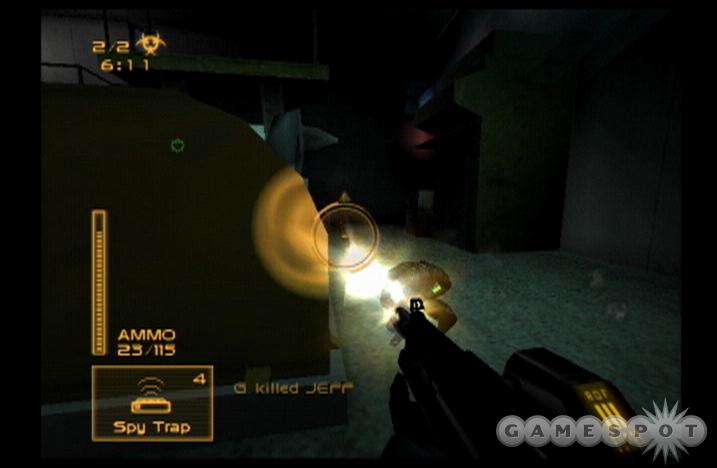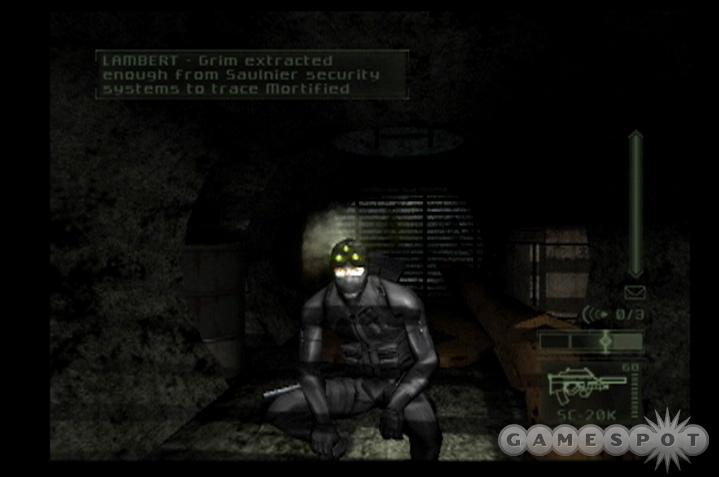Earlier this year, Ubisoft released Xbox and PC versions of the sequel to its blockbuster hit Tom Clancy's Splinter Cell. Pandora Tomorrow not only offered more of the same sort of spectacular single-player stealth action from the first game, again starring ultrasecret agent Sam Fisher, but also boasted a genuinely innovative, new multiplayer mode for up to four players, in which small groups of spies must match wits with heavily armed mercenaries in a deadly game of hide-and-seek. Now this experience can be had in watered-down form on the PlayStation 2. This latest version of the game doesn't look as good as its counterparts, and, in particular, its single-player portion suffers from poor pacing caused by too many abrupt checkpoints, save points, and loading times that have been injected into each level. Fortunately, the multiplayer portion of the game is relatively intact. Nevertheless, if you have the means to play the Xbox or PC version of Pandora Tomorrow instead, then you should. But this is a respectable port overall, and if you consider it only in the context of the PlayStation 2's library, it's still a great game.

The title of Pandora Tomorrow refers to a code phrase used by the presumed villain of the game, a guerrilla leader threatening the free world with a biological contagion. In the single-player portion of the game, you'll reprise the role of Sam Fisher and track this culprit around the globe, in locations ranging from a speeding passenger train hurtling across Paris, to a military camp in Indonesia. The first Splinter Cell game took place predominantly in building interiors, which were richly detailed but naturally mundane. One of Pandora Tomorrow's obvious improvements on its predecessor is in how it takes place in more-exotic locales. In Indonesia, you'll creep through the brush, perhaps using the dense foliage to hide the bodies of your victims out of sight. On the passenger train, you'll shimmy along the outside to avoid detection and will come dangerously close to being flung to your death from the fast-moving car. This train level comes pretty early on in the campaign and is the shortest and probably the most impressive of the game's missions.
There are only eight missions in total, and while the previous versions' levels felt pretty substantial, these missions feel somewhat stripped down--regardless of whether you've played the other versions or not. As mentioned, your progress will be frequently interrupted by invisible barriers; sometimes you'll barely get past one or two guards before the next checkpoint or save point. In consequence, the missions lack a sense of cohesiveness, and when you combine that with this version's less-impressive graphics as compared to its counterparts, the result is a single-player campaign that's still pretty good, but not great.
The core gameplay is basically the same as in the first Splinter Cell. You'll sneak your way through the game's linear scenarios, avoiding or incapacitating any unsuspecting guards (or, sometimes, civilians) who might otherwise threaten your mission of secrecy. It's not difficult to alert passersby to your presence, either by moving too quickly (or otherwise making too much noise) or by blundering into a well-lit area. There are other nasty surprises in store for you. Hidden antipersonnel mines (visible only when you toggle your thermal vision), infrared trip wires (likewise), booby traps, motion detectors, security cameras, and other such devices can make the going pretty tough at times.
You've got plenty of tricks up your sleeve, too. Fisher is typically armed with a silenced pistol as well as his trusty SC20K multipurpose experimental assault rifle, which he can use for some silent sniping when lethal force is permitted or which he can use to fire off a variety of different gadgets. Those who played Splinter Cell will recognize all of these, which range from diversionary cameras to smoke grenades to electrifying (but nonlethal) rounds. Fisher's other gadgets include lock picks, an optical fiber wire used for seeing what's on the other side of a closed door, and his combined night vision/thermal vision goggles. He's decked out to get the job done by any means necessary.

Pandora Tomorrow's storyline is somewhat easier to follow than that of its predecessor, and some of the gameplay elements are thankfully a bit more transparent this time around. For example, the game inherits a somewhat contrived element from its predecessor: In Splinter Cell you needed to hide the bodies of your victims out of sight to avoid setting off an alarm, which would possibly result in the failure of your mission. You needed to hide all bodies even when there was no one left conscious to pay them much heed. Pandora Tomorrow at least makes it clear that this is always necessary, since you'll be chastised for not doing it. Also, in most missions, you don't automatically fail if an alarm is sounded; you'll be afforded up to three such mistakes, though at scripted points in each mission, the alarm stage will reset back to zero, and you'll be able to proceed somewhat less anxiously.
Yet, much like the original Splinter Cell, it must be said about Pandora Tomorrow that it occasionally devolves into pure trial-and-error gameplay. The missions are completely linear and tightly scripted, so if you're jumped by bad guys or you stumble over a trap of some sort and thus fail your mission, you'll just reload from the last checkpoint, and then try again, this time knowing exactly what's coming up. That doesn't necessarily mean you'll always get through the tight spots on the second attempt, as in fact, Pandora Tomorrow can be pretty tough. Some sequences demand you to silently make your way through environments while using both your night vision and your thermal vision to see all the dangers in your surroundings. Then you might need to silently take out a small squad of guards.

Enemy artificial intelligence is about the same as in the previous Splinter Cell, which means guards will basically patrol around in a set pattern, giving you the opportunity to sneak up on them or shoot them. If you make too much noise or otherwise reveal your position, though, they'll either come investigate if you weren't too blatant about it (usually setting themselves up for an easy kill or knockout), or they'll open fire and sound an alarm. Fisher can't sustain much damage, but it's still quite easy to outshoot your enemies as long as you don't alert too many of them at a time. The fact that the gameplay sequences in which you aren't permitted to use lethal force are so much harder than the ones in which you can shoot to kill says a lot about the AI. Strangely enough, the AI seems to have worsened in translation to the PlayStation 2, in how enemies seem to have a distinctly easier time engaging Sam from a distance than from close range, where they'll often stumble about, unable to draw a bead on him. Simply put, the enemy behavior in combat just isn't very convincing here. A side-effect of this is that the game itself is less challenging than the other versions.
Those who've played other versions of Pandora Tomorrow will also spot a few, negligible additions in this version, such as a new type of minigame for defusing trip-wire booby traps and a new rappelling sequence in one of the missions in Indonesia. There's also a rudimentary mission results screen in between each level, though it doesn't give you any incentive to retry a mission. These types of things don't make up for the compromises made to the single-player portion of the game. One of the biggest issues with this version is that the lighting effects have been substantially toned down, resulting in a much more rigid sense of where it's dark and where it's light--but the shadows onscreen aren't necessarily a good indicator of how concealed you are. You'll end up staring at the little light meter in the corner of the screen rather than intuitively sticking to where it's dark. It's easy to nitpick over these types of things, but at any rate, single-player Pandora Tomorrow has a number of memorable moments that shine through even in this version of the game.
Multiplayer Pandora Tomorrow is based on a key plot point, which is alluded to peripherally during Sam Fisher's single-player adventures. Basically, a group called Shadownet--consisting of stealthy guys very much like Sam Fisher, only their faces are completely covered--is charged with sneaking into key areas to dispose of biological weapons in the vicinity. An opposing mercenary force, ARGUS Corp., is commissioned to prevent Shadownet from succeeding. The big twist is that mercenary players view the action from a first-person perspective--and control the action just like in a conventional first-person shooter.

The ARGUS mercs aren't just thugs. Their multipurpose assault rifles are equipped with optional laser sights and torch lights for target identification, and their helmets feature two special vision modes, which allow them to detect spies lurking in the darkness, or traces of their special gadgets. Mercs also have access to anti-spy mines, various grenades, and spy traps, which can cause unsuspecting spies to give away their position. The spies, meanwhile, aren't just Sam Fisher clones, and you'll notice that they control quite differently in some ways. Plus, they have a bunch of unique gadgets of their own. Their electromagnetic rifles are nonlethal but can be used to disable security cameras, motion sensors, and laser trip wires or to temporarily stun enemy mercenaries. Spies also pack flashbang grenades for blinding those pesky mercs and chaff grenades for temporarily disrupting static defenses. They've even got spy bullets, which can mark enemy mercs, revealing their positions on the spies' radars, and allowing the spies to eavesdrop on that merc's voice communications. They can also creep up behind and put unsuspecting mercenaries in a vice grip, in true Sam Fisher style, and then knock them out or kill them.
As you might expect, multiplayer Pandora Tomorrow is a team-oriented affair, and it encourages verbal communication between teammates via communicator headsets--but in a cool touch, if a spy grabs hold of a mercenary, the spy can offer some parting words to the opponent before breaking his neck. It's not game over for the spies if they're caught on camera, but their positions will be revealed on the mercs' minimaps, and sometimes, the area they're in will be temporarily sealed off. Death isn't necessarily the end, either, as both sides have a limited number of lives with which to try to complete their objectives.

The multiplayer action is limited to just four players at a time, and the teams needn't be balanced, so you can have three-on-one matches if you like. There are actually three distinct multiplayer game types based on the aforementioned premise. In the neutralization mode, Shadownet needs to get to and disable several different viral containers, and ARGUS needs to stop them. Extraction mode is kind of like Counter-Strike's hostage rescue; Shadownet needs to find the viral containers and bring them to an extraction point, and ARGUS needs to prevent that from happening. Sabotage is similar to neutralization, but here Shadownet must dispose of the viral containers by hacking into them using modems. It takes a while for the modems to finish the job, so ARGUS has an opportunity to destroy them before the countdown is complete, while Shadownet must make sure the job isn't interrupted.
It seems like it's been a while since any game's multiplayer mode actually warranted a detailed explanation, and that says a lot for the creativity and innovation of this mode. It's executed quite well, too, and can be extremely entertaining if you're playing in good company. The first time you try multiplayer, you're given a quick interactive tutorial of both the Shadownet and ARGUS sides, though you'll need a lot more practice than that. There are just eight maps to choose from (they're the same as the ones found in the Xbox and PC versions of the game), which differ significantly from the single-player settings and include a hospital, a movie theater, a museum, a laboratory, and others. These maps are all shrouded in darkness and lined with air ducts, hidden passageways, multiple points of entry, and other such tactical complexities, so gameplay is still fundamentally all about stealth and tactics--and teamwork, since you'll probably be working with a partner. They're all complexly designed, and neither too small nor too big for four players, so they make for some good, tense action and would probably take a while to really master. Some of them are suitable for one-on-one showdowns, but four-player matches are ideal.
As mentioned, the PS2 version of Splinter Cell Pandora Tomorrow doesn't look as impressive as previous versions, but it's still a great-looking PS2 game. Sam Fisher and his foes mostly recycle the same animations from the original Splinter Cell, so the visuals won't necessarily be as breathtaking as when you saw them the first time (though Fisher has a few cool, new animations you'll notice). But the animations still look terrific, and a lot of the lighting effects and new environments look very good as well. The game's frame rate isn't perfectly smooth, but it maintains well in both single-player and multiplayer modes. Also, some of the new graphical effects for the multiplayer mode are very nice, such as how the ARGUS mercs' vision gets distorted with static when they take a hit. The ARGUS mercs' perspective is probably the single most visually impressive aspect of the game, since the way everything moves from this first-person viewpoint really does give the impression that you're one of these heavily armed and armored troopers. It's a more convincing effect than in just about any other first-person-perspective game on the PS2.

Most of the audio in Pandora Tomorrow is also excellent, especially Sam Fisher's gravelly voice-over, again provided by career tough-guy actor Michael Ironside. There's some pretty great, dry banter between Fisher and his commanding officer during the course of the game, which helps flesh out these characters a bit more. However, a lot of the voice-over for the game's secondary characters is surprisingly bad--and not only is it amateurish, but it just doesn't fit. The illusion that you're in these various international hotspots is shaken by the fact that almost every voice you hear is speaking in fluent, unaccented English. Fortunately, the rest of the game's audio fares much better. An appropriately tense-sounding musical score again picks up and trails off depending on whether you're sneaking or fighting for your life (though, as in Splinter Cell, the musical transitions are overly abrupt, and the way the music loops is a bit too noticeable). Ambient noises and various footstep sounds are all very well done.
Judged solely on its single-player offering, Pandora Tomorrow would still be a pretty good follow-up to its predecessor. But then there's the fascinatingly complex multiplayer mode, which truly is one of a kind and potentially gives Pandora Tomorrow much more lasting value than its predecessor. It's true that this version of Pandora Tomorrow isn't as great as the other versions out there. But if you don't have those other versions as a frame of reference, and you approach this latest version of Pandora Tomorrow with an open mind as well as a desire to fully explore both its single-player and multiplayer portions, you'll likely have a great time with it.